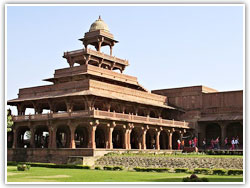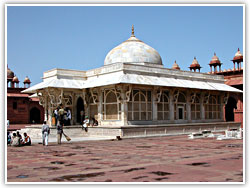|
|
Fatehpur Sikri, Agra
.............................................................................................................................................................................. |
|
Tourist Attractions in Fatehpur Sikri
|
|
|
|
The Royal Palace
The Fatehpur Sikri is reached through the Agra Gate.
From Agra Gate you enter the monument by the Naubat
Khana (Music House) where drums were beaten to mark the
Royal Approach. After this is the garden of the
Diwan-iam (Hall of Public Audience). On the west wall is
the platform for the Emperor’s Throne. This backed onto
the private palace. In the centre of the courtyard
behind the throne is the Pachisi Board. This game is
northing like chess even though it uses a similar board.
In the centre, a two storey building stands on its own.
It is a single room with a throne platform. Here Akbar
would spend long hours in discussion with the Fathers
from Goa, Jains, Buddhist Monks, Hindu Pandits
(Teachers). They would sit along the walls of the
balcony connected to the Throne Pillar by screened
walkways, while courtiers could listen to the discussion
from the ground floor. The decorative techniques and
metaphysical labels are incorporated into Fatehpur Sikri.
The pillar, for example is shaped like a lotus, a Hindu
and Buddhist motif, a Hindu Royal Umbrella, and the Tree
of Life. The bottom of the pillar is carved in tiers;
the first in Muslim designs, the second Hindu, the third
Christian and the fourth Buddhist.
The Throne Pillar can be approached
by steps from the outside. The design of the Hall
deliberately followed the archaic universal pattern of
establishing a hallowed spot from which spiritual
influence could radiate. In his later years, Akbar
developed a mystical cult around himself that saw him as
being semi-divine. He appreciated that he could not draw
Hindus and Muslims away from their religion but by
raising himself to semi-divine status he realized that
for his subjects it would be akin to a religious duty to
obey and a sacrilege to oppose. In this way he won the
allegiance of Hindus and Muslims alike.
In the northwest corner of the
courtyard is the Treasury which comprises three rooms
each protected by a narrow corridor round it. This was
for sentries to guard the money. The ceiling struts
emerge from the jaws of the mythical sea dragons (makaras)
who are the guardians of the treasures of the deep. The
serpentine scrolls derive from Jain architecture from
west India. Sightly in front of the Treasury is The
Astrologer’s Seat. Whilst not addicted to it like his
father Humayun, astrology played an important role in
the running of court affairs. Akbar kept Hindu and
Muslim astrologers. It is also possible that it was used
by the Court Treasurer. The Palace of the Turkish Wife
is directly opp beyond the Pachisi Board. Despite not
being able to bear him any children the Sultana Ruqayya
Begum was his favourite. Her palace, with a balcony on
each side, is so richly carved that it is like entering
a finely carved Chinese Box. The walls would originally
have been set with semi-precious stones and mirrors to
create a Shish Mahal (Mirror) Palace. The outside has
pillars carved into vines, a very European motif. In the
centre of this smaller courtyard is the Musicians Tank.
In the east corner is the Rosewater Fountain. Next to
this are the Emperor’s Private Quarters. There are two
main rooms on the ground floor. One certainly housed his
library. Although unable to read or write himself, Akbar
loved to have books read to him. It is said that
wherever he went in the empire, his library of 50,000
manuscripts was taken with him. The recesses in the
walls are for this. Behind this room is a larger room,
his resting area. Records indicate that Akbar would have
a Hindu thought. On the first floor is the Khwabgah
(bedroom, or Palace or Dreams). Like the other rooms
this was richly decorated in gold and ultramarine
colours. There is another courtyard which contain the
Zenana (Harem) garden and the Palace of the Christian
Wife (Maryam from Goa). The Persian inscriptions on the
beams are verses by Faizl. |
|
|
|
The Panch (Five) Mahal is the five storeyed
building. This elegant pavilion was a pleasure
palace. To counteract the Indian heat, all
buildings had long overhanging eaves to increase
shade. Shaded arcades were attached and open
basements to allow cool air to flow into the
building. There are 84 ground floor pillars, a
particularly auspicious number as it is the seven
planets multiplied by the 12 signs of the Zodiac.
The second floor pillars (56) all have a different
design. There is the Muslim stalactite design (Mugarna)
and the Hindu vase and foliage motif signifying harvest
and material well-being. From the upper storeys there is
a fine view of the rest of the Fathepur Sikri and the
adjoining countryside.
|
 |
|
|
Through the garden and to the
south is the Hawa Mahal (Palace of Winds) and Jodh Bai’s
Palace. The first storey is open, the second enclosed by
an elaborate jail screen which nevertheless still
allowed free circulation of air. Akbar’s Rajput
princesses lived in this. Jodha Bai, the daughter of the
Maharaja of Amber and mother of Jahangir, lived in the
spacious place in the centre of this area. Assured of
privacy by a 9 m high gate, blending Hindu and Muslims
styles. This was guarded by eunuchs. The six-pointed
stars enclosing a lotus, may be tantric motif
symbolizing the union of male and female. The centre of
the building is a quadrangle around which were the
living quarters of other ladies of the harem. The North
and South wings are roofed in azure tiles from Multan
(Pakistan).
To the northwest of Jodha Bai’s
Palace is Raja Birbal’s House. Birbal, a Hindu Brahmin,
was the brightest of Akbar’s nine Jewels’. Again the
building is a combination of styles. The eaves and
arches decorated with the lotus are typically Indian,
the cusped arches Jain and the floral and geometric
designs are Islamic. Some scholars believe that this
building was not for Birbal, Akbar’s Wazir (Chief
minister) but for his senior queens. South of the Raja’s
house are the Royal Stables, though some have questioned
why stables should be placed next door to the women’s
living quarters. The niches in the walls could have been
used for fodder and the rings for tethering the
emperor’s camels and horses. Leaving the Royal Palace
you now proceed across a car park to the Mosque, the
second part of Fatehpur Sikri. The King’s Gate (Badshahi)
is the entrance Akbar used. Inside is the vast
congregational courtyard (132 m x 111 m). To your right
in the corner is the Jamaat Khana Hall and next to this
the Tomb of the Royal Ladies. The mosque area
(courtyard), mihrab, enclosing wall and the two gates on
the south (Victory Gate) and east (Badshahi) were
constructed in 1571-2 at a cost of Rs. 700,000 and is
modeled on the Bibi Khanam at Samarkand. |
|
|
|
The Tomb of Sheikh Salim Chishti, in the brilliant
white marble, dominates the northern half of the
courtyard. This is a masterpiece and one of the
finest examples of marble work in India.
Serpentine brackets support the eaves and the
carved lattice screens surrounding the pavilion
are stunning pieces of craftsmanship. The canopy
over the tomb is inlaid with mother of pearl. On
the cenotaph is the date of the saint’s death
(1571) and the date of the building’s completion
(1580). Around the arched entrance are inscribed
the |
 |
|
|
names
of God, the Prophet and the 4 caliphs of Islam (rulers –
derived from successors of Mohammad). The shrine is on
the spot of the saint’s Hermitage. Originally the dome
was red sandstone. It was marble veneered in 1806. The
screens were added by Jahangir’s foster brother 1606.
Both Hindu and Muslim women pray at the shrine, tying a
cotton strip to the tomb and hoping for the same miracle
of parenthood that befell Akbar. In the centre of the
wall is the mihrab shrine which, backs on to Mecca and
orientates worshippers towards the Prophet’s city. The
central chamber is flanked by hall with Hindu style
pillars, the first time for over 300 years that Muslim
architects had incorporated a purely Hindu style into a
mosque. The shafts are square, then octagonal, then
16-sided and culminate in a second octagonal section.
The dome was painted in the Persian style. Also in this
building are decorative panels of tiles and the Hindu
satkona (six-pointed star). The final feature dominating
the southern wall is the Victory Gate. Constructed in
1573 to celebrate Akbar’s brilliant conquest of Gujarat,
it sets the style for later gateways. The gate is
approached from the outside by a 13 m flight of steps
and the entrance rises 41 m high. Decoration is quite
plain, thus emphasizing the military character of the
gate. Standing in the central hall and facing the
courtyard there is an inscription on the right.
|
|
|
|
|
|
|
|
|
|
|
|